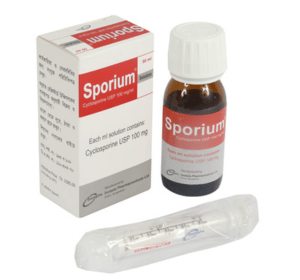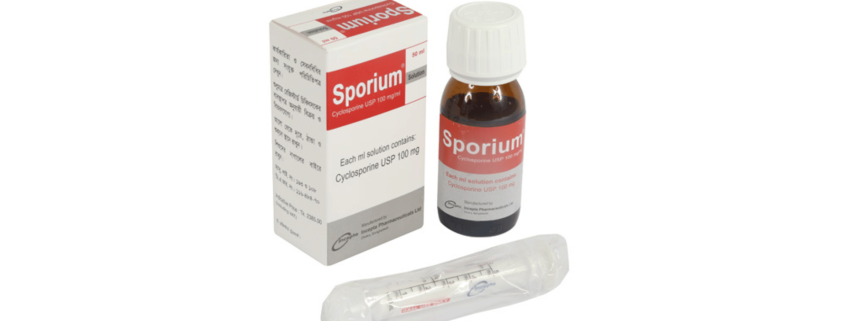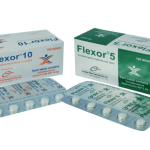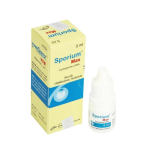Sporium(Cyclosporine)

Therapeutic Group: Immunosuppresant
Presentation
Sporium solution: Each ml solution contains Cyclosporine USP 100 mg.
Description
Cyclosporine is a cyclic polypeptide consisting of 11 amino acids. It is a potent immunosuppressive agent, which prolongs survival of allogeneic transplants of skin, heart, kidney, pancreas, bone marrow, small intestine or lung. Cyclosporine acts specifically and reversibly on lymphocytes. Unlike cytostatic agents, it does not depress haemopoiesis and has no effect on the function of phagocytic cells. Patients treated with Cyclosporine are less prone to infection than those receiving other immunosuppressive therapy.
Indications
Transplantation indications
-Solid organ transplantation
-Bone marrow transplantation-
Non-transplantation indications
-Endogenous uveitis
-Nephrotic syndrome
-Rheumatoid arthritis
-Psoriasis
-Atopic dermatitis
Dosage & Administration
Solid organ transplantation: Initially 10 to 15 mg/kg given in 2 divided doses starting 12 hours before surgery and to continue for 1 to 2 weeks post-operatively. Maintenance dose should be gradually reached to 2 to 6 mg/kg given in 2 divided doses.
Bone marrow transplantation: Initially 12.5 to 15 mg/kg given in 2 divided doses, starting on the day before transplantation. Maintenance treatment of 12.5 mg/Kg in 2 divided doses should be continued for at least 3 months (and preferably for 6 months) before the dose is gradually decreased to zero by 1 year after transplantation.
Endogenous uveitis: Initially 5 mg/kg per day orally given in 2 divided doses are recommended. For maintenance treatment, the dose should be slowly reduced to the lowest effective level.
Nephrotic syndrome: Initially 5 mg/kg for adults and 6 mg/kg for children given in 2 divided doses. In case of renal impairement, the initial dose should not exceed 2.5 mg/kg per day. For maintenance treatment, the dose should be slowly reduced to the lowest effective level.
Rheumatoid arthritis: For the first 6 weeks, the recommended dose is 3 mg/kg per day in 2 divided doses. To achieve full effectiveness, up to 12 weeks of Sporium therapy may be required. For maintenance treatment, the dose has to be titrated individually according to tolerability.
Psoriasis & Atopic dermatitis: Initially 2.5 mg/kg per day orally given in 2 divided doses and 5 mg/kg per day for patients whose condition requires rapid improvement. For maintenance treatment, doses have to be titrated individually to the lowest effective level.
Side Effects
Renal: Renal dysfunction.
Cardiovascular: Hypertension.
Nervous system: Tremor, headache, paraesthesia.
Gastrointestinal tract and liver: Anorexia, nausea, vomiting, abdominal pain, diarrhoea, gingival hyperplasia and hepatic dysfunction.
Metabolic: Hyperlipidaemia, hyperuricaemia, hyperkalaemia, hypomagnesaemia.
Musculoskeletal: Muscle cramps, myalgia and rarely muscle weakness, myopathy.
Haemopoietic: Usually uncommon but anaemia, thrombocytopenia can occur.
Skin and appendages: Hypertrichosis and allergic rashes.
Precautions
Cyclosporine increases the risk of developing lymphomas and other malignancies, particularly those of the skin. So patients should be warned to avoid excess ultraviolet light exposure.
Cyclosporine may develop bacterial, fungal, parasitic and viral infections. So therapeutic strategies should be employed for long-term immunosuppressive therapy.
A reversible increase in serum creatinine and urea may occur during the first few weeks of Sporium therapy and usually responding to dose reduction. In elderly patients, renal function should be monitored with particular care.
Regular monitoring of blood pressure is required during Sporium therapy; if hypertension develops, appropriate antihypertensive treatment must be instituted.
Cyclosporine enhances the risk of hyperkalaemia, especially in patients with renal dysfunction. Caution is also required when Cyclosporine is co-administered with potassium sparing drugs. Cyclosporine enhances the clearance of magnesium. If considered necessary, magnesium supplementation should be given. Caution should be observed in treating patients with hyperuricaemia. During treatment with Cyclosporine, vaccination may be less effective; the use of live-attenuated vaccines should be avoided.
Non-transplant patients with impaired renal function, uncontrolled hypertension, uncontrolled infections, or any kind of malignancy should not receive Cyclosporine.
Use in Pregnancy & Lactation
Pregnancy: There are no adequate and well-controlled studies in pregnant women and, therefore, Sporium should not be used during pregnancy unless the potential benefit to the mother justifies the potential risk to the foetus.
Lactation: Cyclosporine passes into breast milk. Mothers receiving treatment with Sporium should not breast-feed.
Drug Interaction
Drugs that decrease Cyclosporine levels: Barbiturates, carbamazepine, oxcarbazepine, phenytoin, nafcillin, sulfadimidine i.v., rifampicin, octreotide, probucol, orlistat, hypericum perforatum, ticlopidine, sulfinpyrazone, terbinafine, bosentan.
Drugs that increase Cyclosporine levels: Macrolide antibiotics (e.g., erythromycin, azithromycin and clarithromycin), ketoconazole, fluconazole, itraconazole, voriconazole, diltiazem, nicardipine, verapamil, lercanidipine, metoclopramide, oral contraceptives, danazol, methylprednisolone (high dose), allopurinol, amiodarone, cholic acid and derivatives, protease inhibitors, imatinib, colchicine.
Other relevant drug interactions: Cyclosporine may reduce the clearance of digoxin, colchicine, prednisolone and HMG-CoA reductase inhibitors (statins).
Over Dose
Renal dysfunction, which resolve following drug withdrawal, may occur. Elimination can be achieved only by nonspecific measures, including gastric lavage, as Cyclosporine is not dialyzable to any great extent, nor is it cleared well by charcoal hemoperfusion.
Storage
Sporium oral solution should be used within 2 months of opening the bottle and be stored between 15 to 30 °C, preferably not below 20 °C for prolonged periods, as it contains oily components which tend to solidify at low temperatures. A jelly-like formation may occur below 20 °C, which is reversible at temperatures up to 30 °C. Slight sediment may still be observed which does not affect the efficacy and safety of the product.
Commercial Pack
Sporium solution: Each box contains an amber bIottle containing 50 ml solution along with one stopper and one 5ml syringe.



